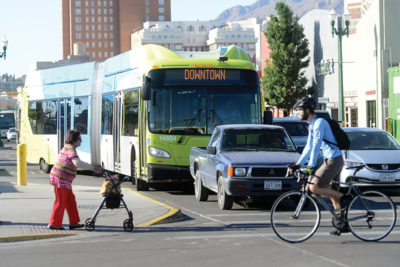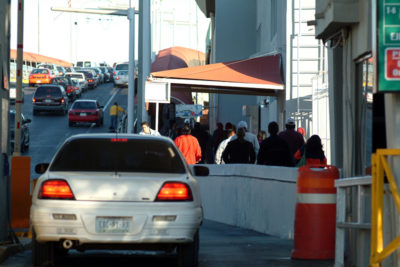In a recent research project, a team from the Texas A&M Transportation Institute’s (TTI’s) Center for International Intelligent Transportation Research (CIITR) addresses unique needs of border transit to inform the next edition of the Transit Capacity and Quality of Service Manual (TCQSM). Currently in its third edition, the manual gives guidance for transit capacity and quality-of-service (QoS) issues and influencing factors. Transportation agencies apply the TCQSM’s techniques to calculate capacity and other operational characteristics for bus, rail, demand-responsive, and other transit services, as well as transit stops, stations, and terminals.

CIITR researchers are currently conducting the project Transit Capacity and QoS Issues at Border Regions. The principal investigator is David Galicia, TTI associate research scientist, and his team includes Kelly Blume, associate research scientist, and Alfredo Sanchez, associate research engineer. The Transportation Research Board recently appointed Galicia to complete a third term as a member of the Standing Committee on Transit Capacity and Quality of Service (AP015).
Paul Ryus, former AP015 chair, says, “The timing of the next edition of the TCQSM, with a two-year production project anticipated to start in the second half of 2022, should work out well to be able to consider the findings of the Transit Capacity and QoS Issues at Border Regions project.”
The project’s goal is to provide documentation of the manual’s components that may lack a border travel perspective but offer opportunities for expansion. The research focus is on transit travel at North American borders such as the U.S.–Mexico and U.S.–Canada borders. The researchers reviewed literature on transit capacity and QoS methods and are contacting border transit agencies about forming focus groups.

With insights from the focus groups, the researchers will choose border regions that experienced rider or system issues and evaluate the regions based on transit capacity and QoS. The team will analyze regional border transit data, as well as demographic, socioeconomic, and geographic data. Then, they will compare the TCQSM’s techniques with the border transit research, and develop recommendations.
“Ideally, our focus groups will be made up of transit systems along the border that match up with potential concept and analysis discrepancies we examined and categorized during the literature review,” shares Blume. “Hearing from transit agencies’ leaders and planning staff will help us get feedback on experiences they’ve had with the TCQSM and any suggestions they have for making it more relevant and useful for their needs.”
The research team will recommend changes to the TCQSM’s current methods to contribute to a better understanding of border-specific scenarios. Recognizing border transit experiences and issues can enhance the manual’s reputation as a reference for transportation agencies, and help planners improve transit performance and services for border regions.
“Correctly evaluating transit service performance measures could improve border transit strategies,” notes Galicia. “Regional transportation planners, for example, could use this research as a guide to prevent performance underestimates or overestimates, which could be costly or even lead to a system failure. Being able to plan ahead, and adjust, could improve transit in border regions.”